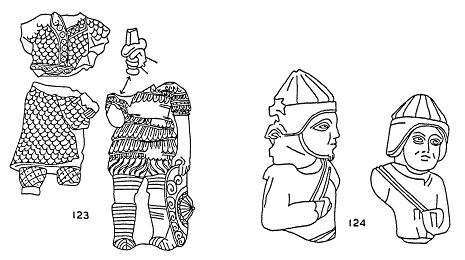ARAB HEAVY CAVALRYMEN
|
An extract from Armies of the Dark Ages 600-1066 by Ian Heath
| |||||
|
An extract from Armies of the Dark Ages 600-1066 by Ian Heath
| |||||
100 & 101. ARAB HEAVY CAVALRYMEN
100 dates to the early-8th century. He wears a long scale corselet, leather coif and a helmet with a solid neck-guard, a type that was called a mighfar. It should be noted that at this date heavy cavalry were pretty rare - of the 4,000 Arabs present at the Battle of Ohud (625) only 800 had armour and at least 600 of these were infantry. On average probably a third of their cavalry at the very most would have been heavies.
101 dates to the 9th or 10th century, by which time armoured cavalry were far more commonplace. He wears a long mail zardfaa (the Byzantine zaba), tall Persian helmet with mail aventail, and wooden or metal greaves and vambraces of Byzantine design, though tubular vambraces of Persian design were also in circulation.
Other types of body-armour included leather and felt corselets as described under 99, plus lamellar and breastplates, probably of Sassanid type. Some armour even had pteruges attached Byzantine-fashion, so it is no surprise that Leo VI says of Arab equipment that it was like that of 'the Romans'.
Both are armed with sword and lance, 101 adding a mace, carried particularly by ghulams, usually on the right side tucked beneath the knee and stirrup strap. Some Arabs also carried an axe suspensed from the saddle.
Only elite cavalrymen such as chieftains or ghulams wore armour, as did standard-bearers, musicians and officers, who may have been distinguished by small bells on their armour.
The Scylitzes ms. shows Arabs wearing similar helmets to that worn by 101 but with a turban wrapped round the lower part, some with scale or lamellar aventails and others with a small, fluttering plume.
